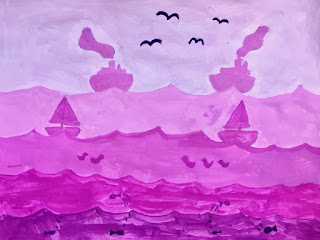We also learned about the concept of atmospheric perspective, which can be seen in many landscape photographs and paintings. Atmospheric perspective describes the effect of objects being lighter in color as they get further away from you, and darker in color when they are closer. In addition, you can see more detail in the foreground and less detail in the background. We looked at some examples of photographs and paintings that demonstrate this concept.



 |
| Bella, 5th Grade (Psychoghios) |
 |
| Aiden, 5th Grade (Twomey) |
 |
| Nolan, 5th Grade (Twomey) |
 |
| Anna, 5th Grade (Twomey) |
 |
| Sona, 5th Grade (Twomey) |
 |
| Aliana, 5th Grade (Twomey) |
 |
| Jack, 5th Grade (Twomey) |
 |
| Emily, 5th Grade (Twomey) |
 |
| Cammy, 5th Grade (Twomey) |
 |
| Domenic, 5th Grade (Domermuth Fantasia) |
 |
| Miah, 5th Grade (Domermuth Fantasia) |
 |
| Yazmin, 5th Grade (Bellis) |
 |
| Sila, 5th Grade (Bellis) |
 |
| LiaLah, 5th Grade (Bellis) |
 |
| Kate S., 5th Grade (Bellis) |
 |
| Tristan, 5th Grade (Bellis) |


































